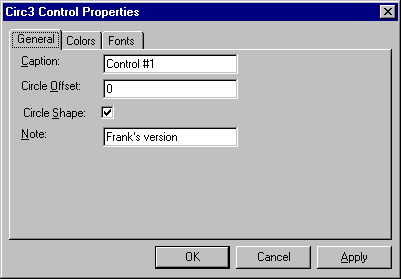
Home | Overview | How Do I | FAQ | Tutorial | Sample
Property pages allow an ActiveX control user to view and change ActiveX control properties. These properties are accessed by invoking a control properties dialog box, which contains one or more property pages that provide a customized, graphical interface for viewing and editing the control properties.
ActiveX control property pages are displayed in two ways:
The properties dialog box (illustrated in the figure below) consists of an area for displaying the current property page, tabs for switching between property pages, and a collection of buttons that perform common tasks such as closing the property page dialog, canceling any changes made, or immediately applying any changes to the ActiveX control.
A Properties Dialog Box

This article covers topics related to using property pages in an ActiveX control. These include:
For more information on using property pages in an ActiveX control, see the following articles:
For information on using property sheets in an MFC application other than an ActiveX control, see the article Property Sheets: Overview.
If you use ControlWizard to create your control project, ControlWizard provides a default property page class for the control derived from COlePropertyPage. Initially, this property page is blank, but you can add any dialog box control or set of controls to it. Because ControlWizard creates only one property page class by default, additional property page classes (also derived from COlePropertyPage) must be created using ClassWizard. For more information on this procedure, see ActiveX Controls: Adding Another Custom Property Page.
Implementing a property page (in this case, the default) is a three step process:
To implement a property page
DoDataExchange function of the control to exchange values between the property page control and the ActiveX control.For example purposes, the following procedures use a simple control (named “Sample”). Sample was created using ControlWizard and contains only the stock Caption property.
To add controls to a property page
ControlWizard appends the name of the project to the end of the dialog ID, in this case, Sample.
For this example, a text label control “Caption :” and an edit box control with an IDC_CAPTION identifier are sufficient.
Now that the user interface has been modified, you need to link the edit box with the Caption property. This is done in the following section by editing the CSamplePropPage::DoDataExchange function.
To enable help in your ActiveX control, call SetHelpInfo from your property page's constructor, and override the property page's OnHelp function to invoke WinHelp.
Here is an example of changing the default property page generated by ControlWizard:
CMyPropPage::CMyPropPage() :
COlePropertyPage(IDD, IDS_MY_PPG_CAPTION)
{
//{{AFX_DATA_INIT(CMyPropPage)
// NOTE: ClassWizard will add member initialization here
// DO NOT EDIT what you see in these blocks of generated code !
//}}AFX_DATA_INIT
SetHelpInfo("Custom Help String goes here!!!","My.hlp",0);
}
BOOL CMyPropPage::OnHelp(LPCTSTR lpszHelpDir)
{
AfxGetApp()->WinHelp(0,HELP_CONTENTS);
return TRUE;
}
The sample TESTHELP demonstrates how to create an ActiveX control with tooltips and Help.
Your property page DoDataExchange function allows you to link property page values with the actual values of properties in the control. To establish links, you must map the appropriate property page fields to their respective control properties.
These mappings are implemented using the property page DDP_ functions. The DDP_ functions work like the DDX_ functions used in standard MFC dialogs, with one exception. In addition to the reference to a member variable, DDP_ functions take the name of the control property. The following is a typical entry in the DoDataExchange function for a property page.
DDP_Text(pDX, IDC_CAPTION, m_caption, _T("Caption"));
This function associates the property page’s m_caption member variable with the Caption property of the control.
Once you have the property page control inserted, you need to establish a link between the property page control, IDC_CAPTION, and the actual control property, Caption.
For more information on this procedure, see Linking Controls with Properties in Tutorials.
DDP functions are available for other dialog control types, such as check boxes, radio buttons, and list boxes. The table below lists the entire set of property page DDP_ functions and their purposes:
Property Page Functions
| Function Name | Use this function to link ... |
| DDP_CBIndex | The selected string’s index in a combo box with a control property. |
| DDP_CBString | The selected string in a combo box with a control property. The selected string can begin with the same letters as the property’s value but need not match it fully. |
| DDP_CBStringExact | The selected string in a combo box with a control property. The selected string and the property’s string value must match exactly. |
| DDP_Check | A check box with a control property. |
| DDP_LBIndex | The selected string’s index in a list box with a control property. |
| DDP_LBString | The selected string in a list box with a control property. The selected string can begin with the same letters as the property’s value but need not match it fully. |
| DDP_LBStringExact | The selected string in a list box with a control property. The selected string and the property’s string value must match exactly. |
| DDP_Radio | A radio button with a control property. |
| DDP_Text | Text with a control property. |
See Also COlePropertyPage